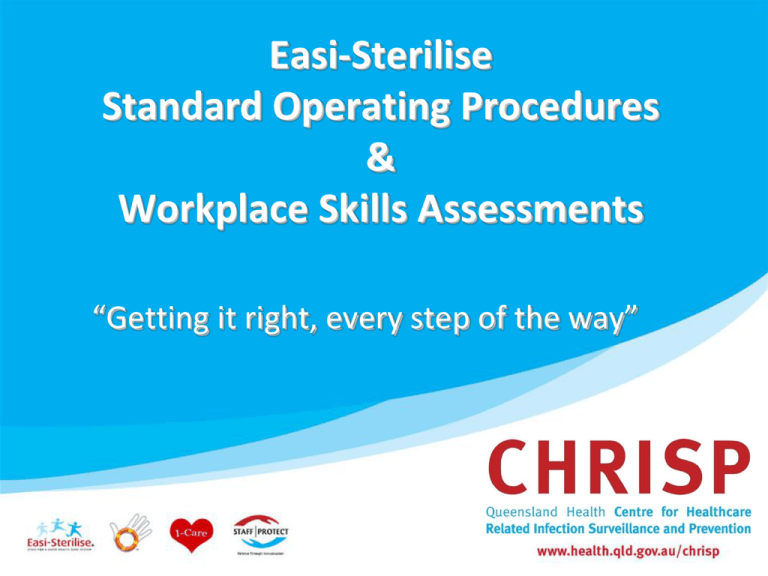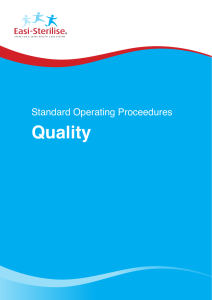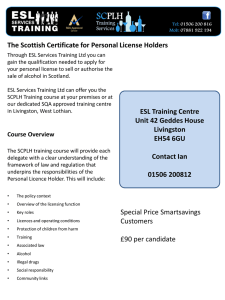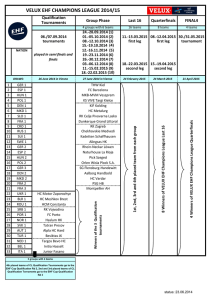5.8 bowie dick type test
advertisement

Easi-Sterilise Standard Operating Procedures & Workplace Skills Assessments “Getting it right, every step of the way” Section 5 Quality 5.1 Water Quality To ensure water used in cleaning of re-usable medical devices is of optimum quality for effective and efficient processing Water quality for cleaning Water quality affects cleaning procedures Water must be potable (drinking quality) Hard water = calcium and magnesium Damages instruments Damages equipment May prevent chemicals working as intended Unfiltered tap water may contain excessive amounts of microorganisms depending on source 5.2 Cleaning Efficacy Test (optional) Challenges the efficacy of the mechanical cleaners At commissioning of mechanical washer to determine loading patterns/configurations Weekly (not mandatory) Conduct tests according to manufacturer’s instructions Record results 5.2 Cleaning Efficacy Test (optional) Possible Causes of Test Failure Overloading of baskets – impedes the free flow of water over items Material incompatibility Blocked jets in the machine Blocked water inlet filter on wash chamber Incorrect cycle temperatures Immediately report any test failures 5.3 Ultrasonic Machine Testing Ensures that the machine is functioning effectively. Testing can be accomplished using validated test methods to prove that the transducers are working effectively soil is able to be removed – new test methods in development Daily test or each day of use Document results Report test failures Ultrasonic cleaning is an effective cleaning method for instruments prior to the reprocessing 5.4 Mechanical Washer Cycle Monitoring Proof that the mechanical washer disinfector attains the correct parameters for the set cycle and thus enables the conditions for effective cleaning and/or thermal disinfection 5.4 Mechanical Washer Cycle Monitoring Washer/disinfectors usually operate within the following temperature ranges Rinsing: 40°C - 50°C Washing: 50°C - 60°C Disinfecting: 70º for 100mins 75º for 30 mins 80º for 10 mins 90º for 1 min Final rinsing: 80°C - 90°C All results shall be checked prior to the release of each load and the printout signed 5.5 Internal & External Chemical Control External and or internal chemical control (indicators) shall be used to identify that an item has been through a sterilising process. The indicators are specific to the sterilising process being used eg. Steam, hydrogen peroxide, ethylene oxide, peracetic acid 5.5 Internal & External Chemical Control Control Pouch (Mandatory) A separate sterilising pouch with a 'control' Class 1 chemical indicator and batch label attached and a Class 5 or 6 Chemical Indicator inside, must be placed onto a sterilizer tray and used in every sterilization cycle. 5.5 Internal & External Chemical Control Internal An appropriate internal multi parameter time and temperature chemical indicator (Class 5 or 6) is used in the following circumstances: In the mandatory OH Control pouch Where delays to access to on-site technical support to undertake calibration, operational qualification and performance qualification for new sterilizers or temporarily loaned sterilizers occur. 5.5 Internal & External Chemical Control External (Mandatory) – Class 1 chemical indicator Examples include; sterilizer indicator tape chemical indicators found on commercially manufactured packs/pouches 5.6 Biological Indicators Biological indicators are used to verify the microbial killing power of 10-6 of the sterilisation process by using a population of calibrated bacterial spores, on, or in, a carrier and packaged in a manner that the integrity of the inoculated carrier is maintained. Routine biological testing is not mandatory for steam sterilisers if process is validated 5.6 Biological Indicators Used Performance qualification (PQ) Operational qualification (OQ) Recommissioning and performance requalification In an emergency, for loads not previously validated. 5.6 Biological Indicators Ensure all from the same batch Check expiry date Different types depending on the length of incubation period and type of sterilisation – not interchangeable If cooling required, follow manufacturer’s instructions If using an incubator need to have that calibrated If a results shows a failure, repeat a second test. 5.7 Leak Rate (Vacuum) Test To verify that air has not leaked into the sterilising chamber. The leak rate/vacuum test is not a sterilisation cycle. It is a special programmed cycle that draws a vacuum and holds the vacuum for a minimum of 10 minutes. If the rate of air that leaks into the chamber via a leaking chamber seal or hole in piping, a pressure rise will be measured that is greater than 1.3 kPa/0.013 bar per min over 10 minutes, a fault indicator and printout. The level of vacuum will be different for each machine. The important thing is that it remains within 1.3 kPa/0.013 bar per min of the vacuum over the 10 minute period. Lisa Sterilisers vacuum test 5.7 Leak Rate (vacuum) Test Class B and Class S sterilisers with air detector – weekly Class B and Class S sterilisers without air detector – daily Record the results. 5.8 BOWIE DICK TYPE TEST 5.8 Bowie Dick Type Test To detect air entrapment and evaluate the ability of a pre-vacuum steriliser to remove residual air that will then allow the steam penetration and attainment of the correct conditions for steam sterilisation. Needs a special cycle Daily on a warmed up steriliser before loads Different types on the market 5.8 BOWIE DICK TYPE TEST 5.8 Bowie Dick Type Test Daily Test Check expiry date of pack with indicator sheet Ensure correct storage of BDT Test Have a colour pass/fail reference sheet Place in empty chamber – close to drain without touching chamber Start “Bowie Dick type cycle” Document results Report abnormal/fail results immediately 5.9 Routine Cleaning of Reprocessing Equipment To ensure that equipment functions correctly oral health/csd staff need to undertake a routine cleaning and checking program of mechanical washers and sterilisers. Ultrasonic cleaners, Washer disinfectors Drying cabinets, Heat sealers Sterilisers 5.9 Routine Cleaning of Reprocessing Equipment Equipment Maintenance example Daily Ultrasonic All internal and external surfaces Washer disinfector Filters, spray arms, drains, door seals, gaskets, Weekly 3 Monthly 6 monthly Clean chamber Replace air filter clean water chambers Drying cabinet All surfaces Filters, door seals, vents, door gaskets. Steam sterilisers Drain, floor of steriliser, door seal, Validation IQ+OQ+PQ Commissioning (IQ) + (OQ) Installation Qualification (IQ) Operational Qualification (OQ) Performance qualification (PQ) Physical qualification & testing Microbiological qualification & testing Commissioning of sterilisers Installation Qualification (IQ) Proves that the steriliser and the where installed comply with the manufacturer’s specifications Operational Qualifications (OQ) Determines that the installed steriliser and equipment is working within the defined limits when used as per manufacturer’s procedures. These shall documented and recorded and include calibration of all gauges, parameter monitoring, the recording device, specific performance tests (eg leak test) and process indicator tests (bowie dick tests) Installation qualification (IQ) Heat distribution study Temperature profile “Cold Spot” Service technician performs (empty chamber) whilst calibrating the temperature gauge. Or may be provided by the manufacturer. Doesn’t need to be routinely checked every time. Annual validation performance qualification (PQ) What is validation? A documented procedure for obtaining, recording and interpreting the results required to establish that a process will consistently yield product complying with predetermined specifications. What does this mean? The entire process is documented, challenged and repeatable, and establishes the efficacy (or not) of the sterilising process, that is monitored by the measurement of the critical requirements of time, temperature and pressure and parameters during each cycle. Validation Documentation Important to document all your procedures! 1. pre-cleaning 2. cleaning 3. drying of instruments 4. packaging 5. Loading steriliser 6. Unloading steriliser 7. physical checks 8. sterilisation log book 9. storage of sterile items 10.validation of YOUR sterilisation process Annual validation for every steriliser Understand the process Document training AND COMPETENCIES of staff protocols Do you use 2 different cycles? Tell the technician both need to be validated Confirm requirements with service technician Create an annual validation report Annual validation Before you start: Determine the hardest-to-sterilise item/pack, this is known as the “challenge packs” and “challenge load”. Select the process parameters including time temperature and pressure i.e. cycles to be used Document pack details – description of contents and diagram of pack layout and load. Document loading/unloading of the steriliser – diagram of loading pattern. Information available for the technician. Performance qualification (PQ) penetration time – document load The time required for the interior of the load/packs to reach the selected temperature after that temperature has been reached in chamber. Thermocouple placement inside the densest area of the challenge pack. Pouches may be zero seconds. Pre-vacuum sterilisers may be zero Penetration time must be added to the required holding time for the selected sterilising temperature. May only need to be done once if no changes to pack contents, packing or loading of the chamber. Performance qualification (PQ) physical qualification Time at temperature and pressure testing Thermocouple testing to ensure the inside of the packs of your challenge load has reached the selected temperature x 3 times with BI’s Hold at or slightly above this temperature and at the correct pressure Must be done at every validation Whole load that will be considered your “validated, challenged load” needs to be available. Performance qualification (PQ) microbiological qualification Microbiological testing is of the “Challenge Load and Pack” done at the same time as the time at temp testing. Label and place one biological indicator in the densest part of the challenge pack. Label and place one biological indicator in the ‘coldest’ part of the chamber. At least, 2 biological indicators used per cycle. Keep a biological indicator outside the chamber as a control (never sterilised – proves the biological indicators were alive). Performance qualification (PQ) microbiological qualification Load the steriliser using the pre-determined loading pattern incorporating the challenge pack. At least, 3 consecutive cycles are run. Each pack must be re-packed with room temperature contents before each of the test cycles are re-run. A single control indicator must be used for all cycles which is never sterilised (control) All indicators (except the control) should show no growth Performance qualification (PQ) microbiological qualification All failures (positive growth from indicators used inside the chamber) must be investigated and documented The whole procedure repeated If the control held outside the chamber does not show positive growth the batch of indicators may be faulty. Summary Staff training & competencies. Instrument reprocessing policies and procedures Completed validation/revalidation certificate Details of heat distribution study (cold spot) Details of penetration time Summary Time at Temperature/Total Processing Time by technician Challenge Pack, Challenge Load and Loading Details Results of three consecutive loads biological indicators (7 minimum) Steriliser Cycle Records More Information Contact: Email: CHRISP@health.qld.gov.au Intranet for SOP & WSA: http://www.health.qld.gov.au/chrisp/sterilising/oral_health _SOP.asp







